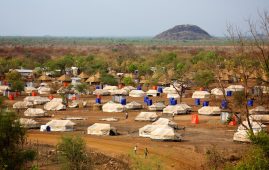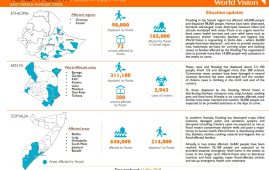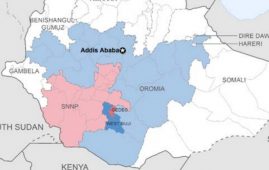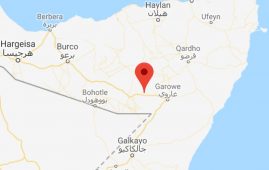Private donors are growing steadily more important to global aid, contributing one-quarter of the estimated US$73.9 billion spent on emergency assistance from 2006 to 2010. Among the favourable factors in private funding are independence from the political motivations of donors, being able to react fast, and the opportunity to focus on forgotten crises, but the lack of tracking creates an information black hole in coordinating aid and evaluating it, says aid funding watchdog Development Initiatives in a new report.
Trusts, foundations, businesses and individuals are the main sources of private funding, but NGOs depend on these sources for 57 percent of their financial support, while the UN agencies studied – the UN World Food Programme (WFP), the UN Children’s Fund (UNICEF), the UN Refugee Agency (UNHCR), the UN Relief and Works Agency for Palestine Refugees in the Near East (UNRWA), and the UN World Health Organization (WHO) – depend on it for only 8 percent.
There are wide variations in the statistics: Médecins Sans Frontières (MSF) gets roughly 90 percent of its funding from private sources but the Norwegian Refugee Council receives only 2 percent; UNICEF raises 20 percent of its funding privately, WFP also gets just 2 percent. Many of the agencies studied are courting private donors for reasons of practicality or principle, and usually both.
Flexibility allows choices
Speed is often of the essence. “When something happens you need to respond, not fill out forms – it’s simple,” said Marc DuBois, executive director of MSF UK. The organization has its own emergency reserve – 15 percent of the overall budget – to tap into for rapid response.
When cholera added to the woes of earthquake victims in Haiti in 2010, many water and sanitation agencies operating there were not able to adjust their programmes to the new crisis because this would have involved lengthy discussions and contract-signing with donors, DuBois said. MSF’s ability to immediately gear up – spending $30-$40 million in two months, building a team of 350 people, and eventually treating 85-90 percent of all cholera patients in Haiti – largely came down to its private money.
Flexible funding also allows MSF to avoid what it sees as politically motivated donors or countries where donors are also belligerents, which could sully the humanitarian principle of independence. MSF refuses institutional money in Somalia, Iraq, Afghanistan, Pakistan and Colombia, though it evaluates needs on a case-by-case basis. “There is a big difference between taking institutional funding for tuberculosis in Swaziland, versus being funded by a belligerent party in a war zone,” DuBois pointed out.
Not all agencies share this approach. The International Committee of the Red Cross and the Red Crescent (ICRC) movement, the world’s largest humanitarian network and in many ways the guardian of the humanitarian principles of independence, impartiality and neutrality, derives 72 percent of its funding from institutional donors. Velina Stoianova, policy adviser at Development Initiatives, commented: “You could say governments fund them [Red Cross], recognizing their special role to try to reach everyone, everywhere, and to retain their independence to do so.”
Private money also enables agencies to focus on neglected sectors such as malnutrition, and slow-burning forgotten crises such as Burundi, Chad and Niger, though inadequate tracking means it is often impossible to map what privately donated aid is spent on.
Where does the money go?
Only five agencies provide financial information disaggregated by source of income: the Canadian Foodgrains Bank, the Danish Refugee Council, the International Medical Corps, MSF, and the Norwegian Refugee Council. These five agencies directed most of their privately funded humanitarian assistance to the Democratic Republic of Congo, Sudan, Haiti, Somalia and Chad.
The world’s top five institutionally funded aid recipients are Sudan, the Occupied Palestinian Territories, Iraq, Afghanistan and Ethiopia.
Fostering stronger partnerships with private donors is a top priority for WFP, says Nancy Roman, Director of Communications Public Policy and Private Partnerships, partly because escalating needs supersede the risks of aid politicization. “People complain no matter who you take your money from… right now we’re reaching 100 million hungry people, but there are one billion out there, so we can’t afford to turn away governments or the private sector or anyone,” she said. Some 35 percent of WFP’s funding comes from the US government.
Everyone is trying to diversify funding sources as the global financial crisis overtakes aid budgets. Stoianova, who is studying these trends for an upcoming report, notes that the Spanish government has slashed development aid by 70 percent and the Netherlands by 40 percent. Other governments in hard-pressed donor countries may follow suit.
The ‘BRICS’ group of economically more advanced emerging countries – Brazil, Russia, India, China and South Africa – is coming to the table, but traditional donors are “maxing out” said Roman. “G8 [Group of 8 Industrialized Nations] donors are hitting the limits of what their publics will allow them to spend to solve problems.”
Although “the money matters”, it is how agencies engage with the private sector that can be even more important, said Roman. “Ten years ago companies did good things because they wanted their picture in the papers – now they’re in it out of compassion, but also as business men and women who understand these people [in need] are their potential customers and suppliers of the future… they recognize they are part of the answer for clean water and sufficient food.”
Private sector funding of WFP has more than doubled in three years, from $20 to $50 million in 2007, to $143 million in 2010, with a target of $200 million by 2017. “We’ll beat the target for sure,” said Roman.
Accountability is harder but better
One in four aid dollars is now privately donated. Stoianova said agencies need to be more transparent, to give the public an accurate picture of where the gaps are “so we can figure out a better division of labour”, and to analyze what people are doing with the money.
DuBois admits it is much harder for private donors to hold agencies to account. “We try to emphasize this,” he said. MSF publishes consolidated accounts for the organization on its website.
But there is still a distance between what organizations do, and the intentions and desires of private donors. “As an aid business we have to do a better job of informing people of what we’re on about,” DuBois said.
From 2006 to 2010, individuals provided the largest proportion of private funding – $13.3 billion – often called “free money” by NGO staff.
“If you show a picture of a starving baby, people give money, and you use it to fund a reforestation programme… it’s not the programme that’s at fault,” said DuBois. “But you have to ask, ‘Did the public have that in mind?’”
***********
* This article first appeared on April 12, 2012 on IRIN (the humanitarian news and analysis service of the UN-OCHA), with the title ‘Aid Policy: Does private money buy independence?’. Items from IRIN are published in this blog with a written permission. Yet, this doesn’t necessarily indicate an endorsement of the claims therein.
Check the drop down menu at the top for related posts.



